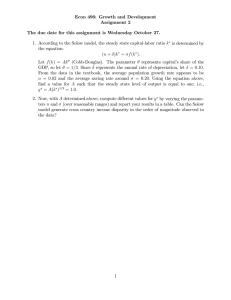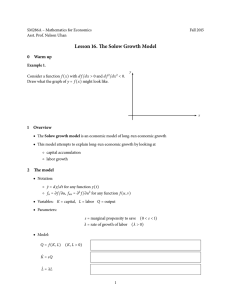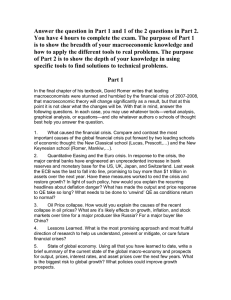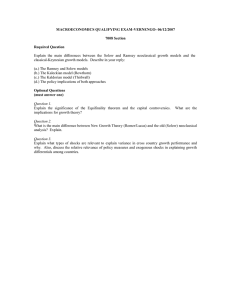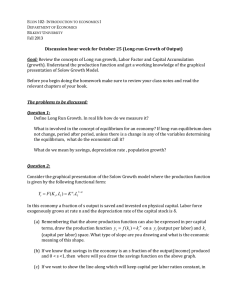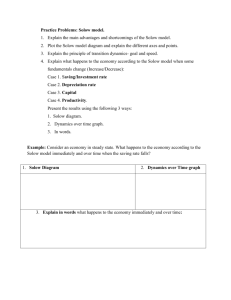Lecture 1 A Simple Representative Model: Two Period
advertisement
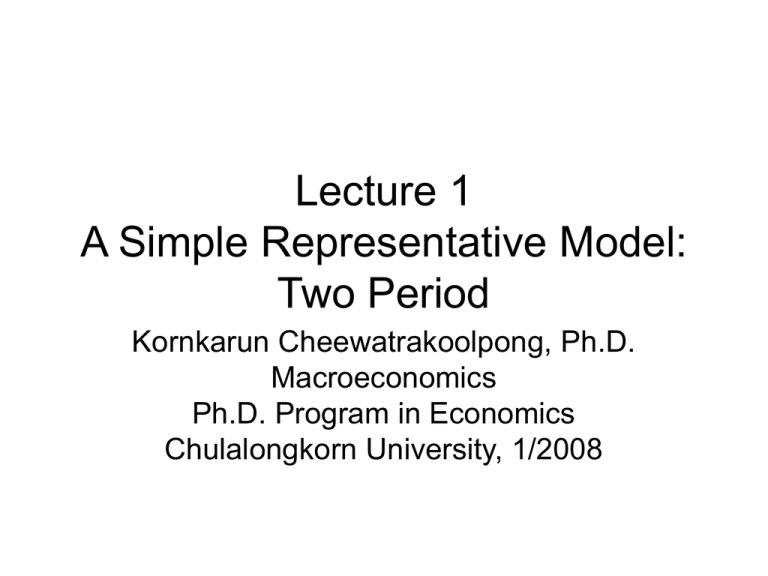
Lecture 1
A Simple Representative Model:
Two Period
Kornkarun Cheewatrakoolpong, Ph.D.
Macroeconomics
Ph.D. Program in Economics
Chulalongkorn University, 1/2008
Reading List
• Manuelli’s notes chapter 1
• Romer chapter 1
Kuhn-Tucker
Consider the following maximization problem:
Max f(x)
s.t. g i ( x) 0
For i = {1,…,m}
Then we can define a saddle function L s.t.
m
L( x, ) f ( x) i g i ( x)
FOC:
m
i 1
Df ( x) Dg i ( x) 0
gi ( x) 0 i 1
i f i ( x) 0, i 0
(1)
(2)
(3)
Kuhn-Tucker
Example: Max lnx + lny
s.t. 2x+y m
Solow Model
• The production function is taken in the
form of: Y(t) = F(K(t),A(t)L(t))
• Assumptions concerning the productions
– CRS in capital and effective labor
F(cK,cAL) = cF(K,AL)
- We can write down the production function in
this form: F(K/AL,1) =(1/AL)F(K,AL)
- Given k=K/AL, y= Y/AL, f(k) = F(k,1), then
y = f(k) output per effective labor
Solow Model
f(k)
f(k) is assumed to be:
- f(0) = 0
- f’(k) >0
- f’’(k) <0
- satisfy inada condition
k
Solow Model
• The evolution of the inputs into Production
– Continuous time model
L(t ) n( L(t ))
A(t ) g ( A(t ))
with n,g are exogeneously given
– Fraction of output for investment = s
– Depreciation rate =
K (t ) sY (t ) K (t )
Solow Model
• Dynamics of the model
K (t )
K (t )
k (t )
[ A(t ) L(t ) L(t ) A(t )]
2
A(t ) L(t ) [ A(t ) L(t )]
K (t )
K (t )
k (t )
[ L(t ) / L(t ) A(t ) / A(t )]
A(t ) L(t ) [ A(t ) L(t )]
sY (t ) K (t )
k (t )
k (t )[n g ]
A(t ) L(t )
k (t ) sf (k (t )) k (t )[n g ]
Solow Model
Investment/AL
(n+g+ )k
sf(k)
k
k*
Solow Model
k
k
k*
Solow Model
• The Balanced growth path (steady state)
When k converges to k*
- labor grows at rate n
- knowledge grows at rate g
- k grows at rate n+g
- AL grows at rate n+g
A Two Period Model
•
•
•
•
Discrete time model
A large number of identical households
Each lives for two periods
The utility is given by:
u(c1 , c2 ) u(c1 ) u(c2 )
• The technology is represented by f(k), using k
units of the first period consumption then you
get f(k) units of the second period
consumption.
A Two Period Model
• Social Planner’s Problem is
max u(c1 ) u(c2 )
s.t.
e c1 k 0
f (k ) c2
A Two Period Model
• Competitive equilibrium
Firm’s problem:
max p2f(k) – p1k
Consumer’s problem:
max u(c1 ) u(c2 )
s.t. p1 (e c1 ) p2c2 0
(Here we assume that a consumer owns firm)
A Two Period Model
•
Competitive equilibrium means the price
(p1,p2) and consumption (c1,c2,k) such
that:
1. k solves firm’s profit maximization
problem.
2. c1,c2 solves consumer’s utility
maximization problem.
3. Market clearing condition
A Two Period Model
• The first welfare theorem
If the vector price p and the allocation
(c1,c2,k) constitute a competitive
equilibrium, then this allocation is the
solution of the planner problem.
Question: Does the first welfare theorem
hold in our setting?
A Two Period Model
• The Second Welfare Theorem
For every Pareto optimal allocation
(c1,c2,k), there is a price vector p such that
(c1,c2,k,p) is a competitive equilibrium.
Question: Does the first welfare theorem
hold in our setting?
A Two Period Model
Example: Human Capital Accumulation
Consider a two period economy in which an individual
who has initial human capital has to decide what
fraction a of his endowment e to allocate to producing
goods in the first period. The fraction 1-a is used to
accumulate human capital. The first period
consumption and the end of period human capital h’
can be written as:
c1 hae
h' h(1 ) zhe(1 a)
c2 h' e
A Two Period Model
Example: Human Capital Accumulation (cont’)
Given that z is the productivity of current human capital.
0 1
is the depreciation rate of human capital.
Each individual has a utility function given by:
u(c1 , c2 ) u(c1 ) u(c2 )
i)
ii)
Assume that all individuals have the same h, find
the solution to the planner’s problem.
Decentralize the solution in i) as a competitive
equilibrium.

